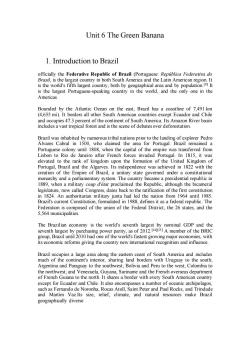《现代大学英语精读》课程教学课件(PPT讲稿)第二版第一册 第1-6单元课外补充资料 unit 6

Unit 6 The Green Banana 1.Introduction to Brazil a scountry in both the Latin gest country,b merican reg is thea Americas t Portuguese-speaking country e only one in the Bounded by the atlantic Ocean on the east brazil has a coastline of 7491 km (4.655 mi).It borders all other South American countries except Ecuador and Chile and occupies 47.3 percent of the continent of South America.Its Amazon River basin includes a vast tropical forest and is the scene of debates over deforestation. Brazil was inhabited by numerous tribal nations prior to the landing of explorer Pedro Alvares Cabral in 1500, who claimed the area for Portugal.Brazil remained a Portuguese colony until 1808,when the capital of the empire was transferred from Janeiro after French forces invaded Portugal 1n1815, t was a f kingdom upon mation of nce was ac 1822s n ed the Re the bpub tes back to the ratification of the firs in 1824.An authoritarian anta had led the nation c 10641 atil 1985 Brazil's current Constitution,formulated in 1988.defines it as a federal republic.The Federation is composed of the union of the Federal District,the 26 states,and the 5.564 municipalities. The Brazilian economy is the world's seventh largest by nominal GDP and the seventh largest by purchasing power parity,as of 2012.1141151 A member of the BRIC group.Brazil until 2010 had one of the world's fastest growing major economies,with ts economic reforms giving the country new international recognition and influence. Brazil occupies a large area along the eastem coast of South America and include much of rentin and nt's inte aguay to th u ivia a Peru to the wes the ot for Ecuador and Chile It also such as Fermando de Noronha.Rocas Atoll.Saint Peter and Paul Rocks.and Trindade and Martim Vaz.Its size,relief,climate,and natural resources make Brazil geographically diverse
Unit 6 The Green Banana 1. Introduction to Brazil officially the Federative Republic of Brazil (Portuguese: República Federativa do Brasil, is the largest country in both South America and the Latin American region. It is the world's fifth largest country, both by geographical area and by population. [9] It is the largest Portuguese-speaking country in the world, and the only one in the Americas. Bounded by the Atlantic Ocean on the east, Brazil has a coastline of 7,491 km (4,655 mi). It borders all other South American countries except Ecuador and Chile and occupies 47.3 percent of the continent of South America. Its Amazon River basin includes a vast tropical forest and is the scene of debates over deforestation. Brazil was inhabited by numerous tribal nations prior to the landing of explorer Pedro Álvares Cabral in 1500, who claimed the area for Portugal. Brazil remained a Portuguese colony until 1808, when the capital of the empire was transferred from Lisbon to Rio de Janeiro after French forces invaded Portugal. In 1815, it was elevated to the rank of kingdom upon the formation of the United Kingdom of Portugal, Brazil and the Algarves. Its independence was achieved in 1822 with the creation of the Empire of Brazil, a unitary state governed under a constitutional monarchy and a parliamentary system. The country became a presidential republic in 1889, when a military coup d'état proclaimed the Republic, although the bicameral legislature, now called Congress, dates back to the ratification of the first constitution in 1824. An authoritarian military junta had led the nation from 1964 until 1985. Brazil's current Constitution, formulated in 1988, defines it as a federal republic. The Federation is composed of the union of the Federal District, the 26 states, and the 5,564 municipalities. The Brazilian economy is the world's seventh largest by nominal GDP and the seventh largest by purchasing power parity, as of 2012.[14][15] A member of the BRIC group, Brazil until 2010 had one of the world's fastest growing major economies, with its economic reforms giving the country new international recognition and influence. Brazil occupies a large area along the eastern coast of South America and includes much of the continent's interior, sharing land borders with Uruguay to the south; Argentina and Paraguay to the southwest; Bolivia and Peru to the west; Colombia to the northwest; and Venezuela, Guyana, Suriname and the French overseas department of French Guiana to the north. It shares a border with every South American country except for Ecuador and Chile. It also encompasses a number of oceanic archipelagos, such as Fernando de Noronha, Rocas Atoll, Saint Peter and Paul Rocks, and Trindade and Martim Vaz.Its size, relief, climate, and natural resources make Brazil geographically diverse

2.Picture of bananas
2.Picture of bananas
按次数下载不扣除下载券;
注册用户24小时内重复下载只扣除一次;
顺序:VIP每日次数-->可用次数-->下载券;
- 《现代大学英语精读》课程教学课件(PPT讲稿)第二版第一册 第1-6单元课外补充资料 unit 5.docx
- 《现代大学英语精读》课程教学课件(PPT讲稿)第二版第一册 第1-6单元课外补充资料 unit 4.docx
- 《现代大学英语精读》课程教学课件(PPT讲稿)第二版第一册 第1-6单元课外补充资料 unit 3.docx
- 《现代大学英语精读》课程教学课件(PPT讲稿)第二版第一册 第1-6单元课外补充资料 unit 2.docx
- 《现代大学英语精读》课程教学课件(PPT讲稿)第二版第一册 第1-6单元课外补充资料 unit 1.docx
- 《现代大学英语精读》课程教学课件(PPT讲稿)第二版第一册 Unit 8 vocabulary.ppt
- 《现代大学英语精读》课程教学课件(PPT讲稿)第二版第一册 Unit 8 B1U08.ppt
- 《现代大学英语精读》课程教学课件(PPT讲稿)第二版第一册 Unit 6 Vocabulary.ppt
- 《现代大学英语精读》课程教学课件(PPT讲稿)第二版第一册 Unit 6 B1U06.ppt
- 《现代大学英语精读》课程教学课件(PPT讲稿)第二版第一册 Unit 5 vocabulary.ppt
- 《现代大学英语精读》课程教学课件(PPT讲稿)第二版第一册 Unit 5 B1U05.ppt
- 《现代大学英语精读》课程教学课件(PPT讲稿)第二版第一册 Unit 4 vocabulary.ppt
- 《现代大学英语精读》课程教学课件(PPT讲稿)第二版第一册 Unit 4 B1U04.ppt
- 《现代大学英语精读》课程教学课件(PPT讲稿)第二版第一册 Unit 3 Vocabulary.ppt
- 《现代大学英语精读》课程教学课件(PPT讲稿)第二版第一册 Unit 3 B1U03.ppt
- 《现代大学英语精读》课程教学课件(PPT讲稿)第二版第一册 Unit 2 Vocabulary.ppt
- 《现代大学英语精读》课程教学课件(PPT讲稿)第二版第一册 Unit 2 B1U02.ppt
- 《现代大学英语精读》课程教学课件(PPT讲稿)第二版第一册 Unit 1 vocabulary.ppt
- 《现代大学英语精读》课程教学课件(PPT讲稿)第二版第一册 Unit 1 B1U01.ppt
- 《现代大学英语精读》课程教学课件(PPT讲稿)第二版第一册 Lesson14 warm-up.ppt
- 《现代大学英语精读》课程教学课件(PPT讲稿)第二版第二册第9单元课件 Lesson12 background information.ppt
- 《现代大学英语精读》课程教学课件(PPT讲稿)第二版第二册第9单元课件 Lesson12 extension.ppt
- 《现代大学英语精读》课程教学课件(PPT讲稿)第二版第二册第9单元课件 Lesson12 language study.ppt
- 《现代大学英语精读》课程教学课件(PPT讲稿)第二版第二册第9单元课件 Lesson12 text appreciation.ppt
- 《现代大学英语精读》课程教学课件(PPT讲稿)第二版第二册第9单元课件 Lesson12 warm-up.ppt
- 《现代大学英语精读》课程教学课件(PPT讲稿)第二版第二册第1单元课件 Lesson1 background information.ppt
- 《现代大学英语精读》课程教学课件(PPT讲稿)第二版第二册第1单元课件 Lesson1 extension.ppt
- 《现代大学英语精读》课程教学课件(PPT讲稿)第二版第二册第1单元课件 Lesson1 language study.ppt
- 《现代大学英语精读》课程教学课件(PPT讲稿)第二版第二册第1单元课件 Lesson1 text appreciation.ppt
- 《现代大学英语精读》课程教学课件(PPT讲稿)第二版第二册第1单元课件 Lesson1 warm-up.ppt
- 《现代大学英语精读》课程教学课件(PPT讲稿)第二版第二册第3单元课件 Lesson 5 language study.ppt
- 《现代大学英语精读》课程教学课件(PPT讲稿)第二版第二册第3单元课件 Lesson5 extension.ppt
- 《现代大学英语精读》课程教学课件(PPT讲稿)第二版第二册第3单元课件 Lesson5 text appreciation.ppt
- 《现代大学英语精读》课程教学课件(PPT讲稿)第二版第二册第2单元课件 Lesson 5 language study.ppt
- 《现代大学英语精读》课程教学课件(PPT讲稿)第二版第二册第2单元课件 Lesson5 background information.ppt
- 《现代大学英语精读》课程教学课件(PPT讲稿)第二版第二册第2单元课件 Lesson5 extension.ppt
- 《现代大学英语精读》课程教学课件(PPT讲稿)第二版第二册第2单元课件 Lesson5 text appreciation.ppt
- 《现代大学英语精读》课程教学课件(PPT讲稿)第二版第二册第2单元课件 Lesson5 warm-up.ppt
- 《现代大学英语精读》课程教学课件(PPT讲稿)第二版第二册第4单元课件 Lesson6 background information.ppt
- 《现代大学英语精读》课程教学课件(PPT讲稿)第二版第二册第4单元课件 Lesson6 extension.ppt
